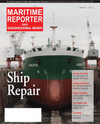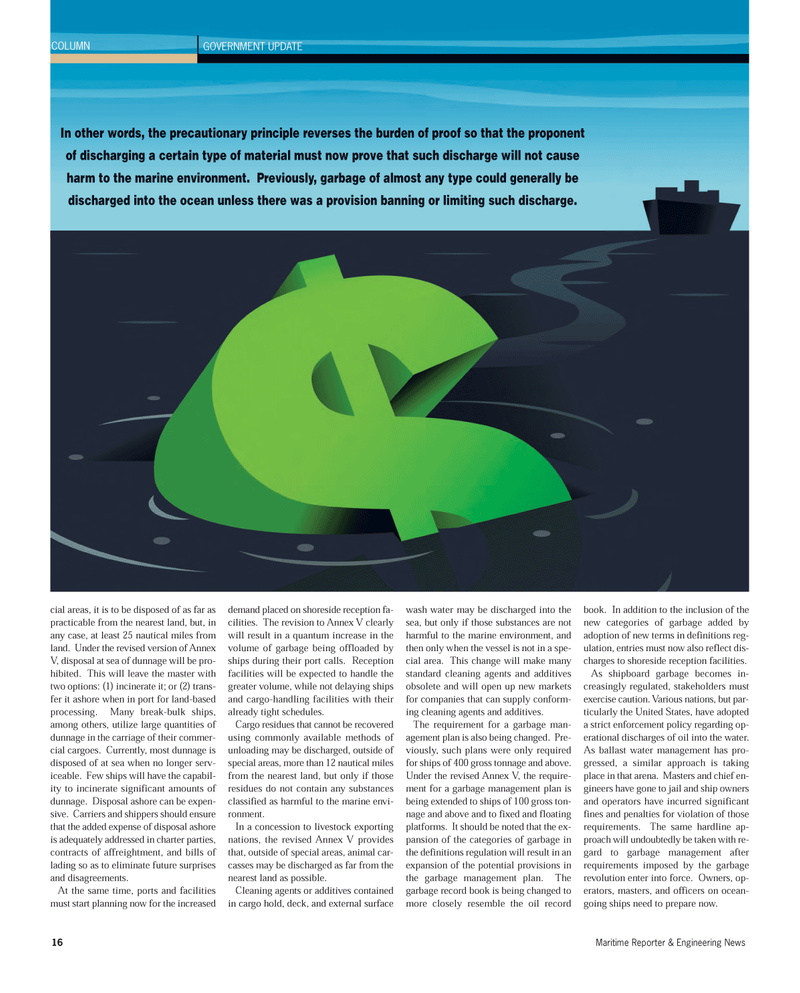
Page 16: of Maritime Reporter Magazine (March 2012)
The Ship Repair Edition
Read this page in Pdf, Flash or Html5 edition of March 2012 Maritime Reporter Magazine
16Maritime Reporter & Engineering News COLUMNGOVERNMENT UPDATE cial areas, it is to be disposed of as far as practicable from the nearest land, but, inany case, at least 25 nautical miles from land. Under the revised version of Annex V, disposal at sea of dunnage will be pro- hibited. This will leave the master with two options: (1) incinerate it; or (2) trans- fer it ashore when in port for land-basedprocessing. Many break-bulk ships, among others, utilize large quantities of dunnage in the carriage of their commer- cial cargoes. Currently, most dunnage is disposed of at sea when no longer serv-iceable. Few ships will have the capabil- ity to incinerate significant amounts of dunnage. Disposal ashore can be expen- sive. Carriers and shippers should ensure that the added expense of disposal ashore is adequately addressed in charter parties,contracts of affreightment, and bills of lading so as to eliminate future surprisesand disagreements. At the same time, ports and facilities must start planning now for the increased demand placed on shoreside reception fa- cilities. The revision to Annex V clearly will result in a quantum increase in thevolume of garbage being offloaded by ships during their port calls. Receptionfacilities will be expected to handle the greater volume, while not delaying ships and cargo-handling facilities with their already tight schedules. Cargo residues that cannot be recovered using commonly available methods of unloading may be discharged, outside of special areas, more than 12 nautical milesfrom the nearest land, but only if those residues do not contain any substances classified as harmful to the marine envi- ronment.In a concession to livestock exporting nations, the revised Annex V provides that, outside of special areas, animal car- casses may be discharged as far from the nearest land as possible.Cleaning agents or additives contained in cargo hold, deck, and external surface wash water may be discharged into the sea, but only if those substances are not harmful to the marine environment, and then only when the vessel is not in a spe- cial area. This change will make many standard cleaning agents and additives obsolete and will open up new markets for companies that can supply conform-ing cleaning agents and additives. The requirement for a garbage man- agement plan is also being changed. Pre-viously, such plans were only required for ships of 400 gross tonnage and above. Under the revised Annex V, the require- ment for a garbage management plan is being extended to ships of 100 gross ton- nage and above and to fixed and floating platforms. It should be noted that the ex- pansion of the categories of garbage in the definitions regulation will result in an expansion of the potential provisions in the garbage management plan. The garbage record book is being changed to more closely resemble the oil recordbook. In addition to the inclusion of thenew categories of garbage added by adoption of new terms in definitions reg- ulation, entries must now also reflect dis- charges to shoreside reception facilities. As shipboard garbage becomes in- creasingly regulated, stakeholders must exercise caution. Various nations, but par- ticularly the United States, have adopted a strict enforcement policy regarding op- erational discharges of oil into the water. As ballast water management has pro- gressed, a similar approach is takingplace in that arena. Masters and chief en-gineers have gone to jail and ship owners and operators have incurred significant fines and penalties for violation of those requirements. The same hardline ap- proach will undoubtedly be taken with re- gard to garbage management after requirements imposed by the garbage revolution enter into force. Owners, op- erators, masters, and officers on ocean- going ships need to prepare now. In other words, the precautionary principle reverses the burden of proof so that the proponent of discharging a certain type of material must now prove that such discharge will not cause harm to the marine environment. Previously, garbage of almost any type could generally be discharged into the ocean unless there was a provision banning or limiting such discharge. MR March 12 # 2 (9-16):MR Template 3/2/2012 10:53 AM Page 16

 15
15

 17
17
